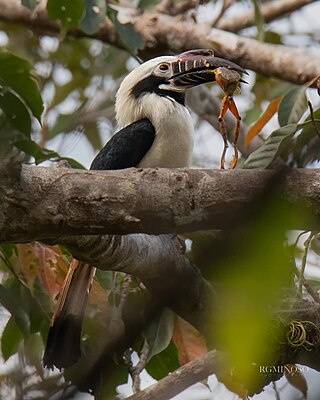
The Visayan hornbill is a hornbill found in tropical moist lowland forests of the Philippines in the Western Visayas region which includes the islands of Panay, Negros and formerly as well as the island of Masbate, and formerly Ticao, in the Philippines. As is the case with all five Philippine tarictic hornbills, formerly considered to be just one species.It is declining due to habitat destruction, hunting and the illegal wildlife trade.

Walden's hornbill locally called dulungan, also known as the Visayan wrinkled hornbill, rufous-headed hornbill or writhe-billed hornbill, is a critically endangered species of hornbill living in the rainforests on the islands of Negros and Panay in the Philippines. It is closely related to the writhed hornbill, but can be recognized by the yellow throat and ocular skin in the male, and the blue throat and ocular skin in the female. Its binomial name commemorates the Scottish ornithologist Viscount Walden.

The Mindanao hornbill, also known as the Mindanao tarictic hornbill, is a medium-small species of hornbill found in the canopy of rainforests on Mindanao, Dinagat, Siargao and Basilan in the southern Philippines. All five Philippine tarictics were once considered a single species. Its population declining due to habitat destruction, hunting and the illegal wildlife trade.
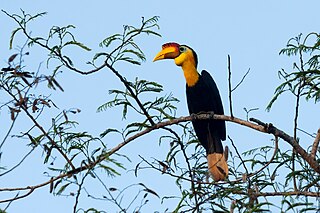
The wrinkled hornbill or Sunda wrinkled hornbill is a medium-large hornbill which is found in forest in the Thai-Malay Peninsula, Sumatra and Borneo.

Austen's brown hornbill is a species of hornbill found in forests from northeastern India and south to Vietnam and northern Thailand. It is sometimes included as a subspecies of Tickell's brown hornbill.
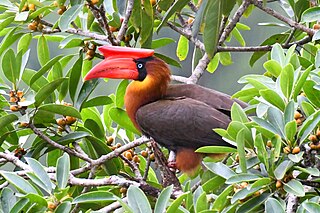
The rufous hornbill, also known as the Philippine hornbill and locally as kalaw, is a large species of hornbill endemic to the Philippines. They are referred by locals as the "clock-of-the-mountains" due to its large booming call which typically occur of every hour. It occurs in moist tropical lowland forest. They are now considered to be a threatened species and its reasons for decline being habitat destruction, hunting and poaching for the illegal pet trade.

The Philippine tailorbird, also known as the Visayan tailorbird or the Chestnut-crowned tailorbird is a species of bird formerly placed in the "Old World warbler" assemblage, but now placed in the family Cisticolidae. It is native to the Philippines in Western Visayas. Its natural habitats are tropical moist lowland forests, tropical mangrove forests and secondary growth.

The rufous-fronted tailorbird is a species of bird formerly placed in the Old World warbler assemblage, but now placed in the family Cisticolidae. It is native to the southern and eastern Philippines. Its natural habitats are tropical moist lowland forests and tropical mangrove forests.
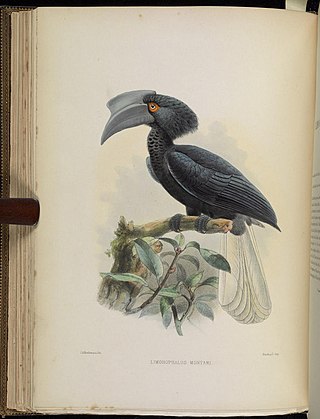
The Sulu hornbill, or Montano's hornbill, is a species of hornbill in the family Bucerotidae. It is endemic to the Sulu archipelago in the Philippines, with the remaining populations in Tawi-Tawi with it believed to be hunted to extinction on Jolo. Its natural habitat is tropical moist forests. It is threatened by habitat loss as well as potential harvesting for food. Its diet includes fruit, insects, and small lizards.
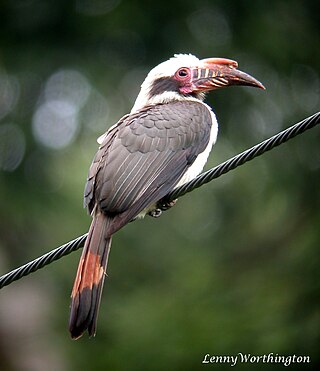
The Luzon hornbill, sometimes called Luzon tarictic hornbill, is a species of hornbill in the family Bucerotidae. It is endemic to forests on Luzon and nearby islands in the northern Philippines. All five Philippine tarictics were once considered a single species. It is declining due to habitat destruction, hunting and the illegal wildlife trade.

The Mindoro hornbill is a species of hornbill in the family Bucerotidae. It is endemic to forests on Mindoro in the Philippines found in tropical moist lowland forests. As is the case with all five Philippine tarictic hornbills, formerly considered to be just one species. It is the only tarictic hornbill where both sexes are creamy-white and black. The sexes are very similar, differing primarily in the colour of the ocular ring. It is threatened by habitat loss, and is consequently considered endangered by the IUCN.

The Samar hornbill is a species of hornbill in the family Bucerotidae. It is found in forests on the islands of Samar, Calicoan, Leyte and Bohol in the east-central Philippines. As is the case with all Philippine tarictic hornbills, it has been considered a subspecies of Visayan hornbill Alternatively, it is considered a subspecies of Mindanao hornbill.

The black-faced coucal is a species of cuckoo in the family Cuculidae. It is endemic to the Philippines found in the islands of Mindanao, Basilan Dinagat Islands Bohol, Leyte, Biliran and Samar. It is a striking coucal with its cream head contrasted with a black mask and tail and chestnut wings. Its natural habitat is tropical moist lowland forest.

The rufous coucal is a species of cuckoo in the family Cuculidae. It is found in Luzon and proximate islands in the Philippines. Its natural habitat is tropical moist lowland forest. It is threatened by habitat loss. Along with the Philippine coucal, Black-faced coucal and the critically endangered Black-hooded coucal, it is one of the 4 endemic coucals.
The Tawitawi brown dove, also dark-eared brown dove, is a threatened species of bird in the family Columbidae noted for its orange-peach breast. It is endemic to forests in the Sulu Archipelago in the Philippines. Until recently it was considered conspecific with the Mindanao brown dove and collectively called the dark-eared brown dove. Although threatened by habitat loss, the rate of loss significantly reduced from 2004 to 2007, and it was thus downlisted from Critically Endangered to Endangered status in the 2007 IUCN Red List.

The blue-capped kingfisher, also known as Hombron's kingfisher, is a species of bird in the family Alcedinidae endemic to the Philippines and found only on Mindanao. It is one of the most colorful kingfishers in the country having a dark blue cap and wings with rufous spots, a striped rufous belly, white chin and red bill. Its natural habitats are on the upper ranges of tropical moist lowland forest and tropical moist montane forests. It is threatened by habitat loss.

The Palawan blue flycatcher is a species of bird in the family Muscicapidae. It is endemic to the Philippines found only on Palawan and its surrounding islands.

The rusty-crowned babbler is a species of bird in the family Zosteropidae. It is native to the southern Philippines on the islands of Mindanao and Dinagat Islands and Basilan. Its natural habitat is tropical moist lowland forest.

The Mindanao boobook or Mindanao hawk-owl is a species of owl in the family Strigidae that is endemic to the Philippines on the island of Mindanao. It was previously known as a subspecies of the Philippine hawk-owl, but was reclassified in 2012, as voice and other evidence suggested it a distinct species. It is found in tropical moist lowland forest. It is threatened by habitat loss.

The Sulu boobook or Sulu hawk-owl is a species of owl in the family Strigidae. It is endemic to the Sulu Archipelago in the Philippines. It was previously known as a subspecies of the Philippine hawk-owl, but was reclassified in 2012, as voice and other evidence suggested it was a distinct species. It is found in tropical moist lowland forest. It is threatened by habitat loss.






















